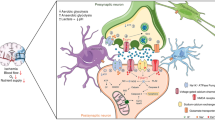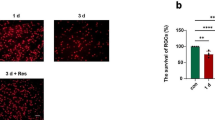Abstract
Acute excitotoxicity in the chick retina is characterized by cellular swelling and the subsequent selective release of GABA. In order to understand the source of GABA release, embryonic day 15 retina were incubated with 1mM glutamate for 30 min in the presence or absence of the GABA transport inhibitor SKF 89976A (1–100 μM). SKF 89976A dose-dependently attentuated glutamate-induced GABA release (IC50, 39 μM). Histological examination of retina showed that SKF 89976A greatly reduced cellular swelling caused by glutamate exposure. Interaction of SKF 89976A with glutamate receptors was ruled out as a possible reason for protection vs acute glutamate excitotoxicity, since SKF 89976A had no effect on glutamate receptor-induced22Na+ influx. In contrast, the NMDA antagonist, MK-801, significantly blocked glutamate-evoked22Na+ uptake. These studies indicate that reversal of the GABA transporter contributes to the bulk of GABA release during acute excitotoxicity in retina. Further, a net effect of the presence of SKF 89976A during glutamate exposure is reduction in cellular swelling. It is not clear at present if attenuation of swelling is mediated specifically by an interaction with the GABA transporter or by a nonspecific or indirect effect of SKF 89976A.
Similar content being viewed by others
References
Belhage B., Hansen G. H., and Schousboe A. (1993) Depolarization by K+ and glutamate activates different neurotransmitter release mechanisms in GABA-ergic neurons: Vesicular versus non-vesicular release of GABA.Neuroscience 54, 1019–1034.
Cammack J. N. and Schwartz E. A. (1993) Ions required for the electrogenic transport of GABA by horizontal cells of the catfish retina.J. Physiol. 472, 81–102.
Corey J. L., Guastella J., Davidson N., and Lester H. A. (1994) GABA uptake and release by a mammalian cell line stably expressing a cloned rat brain GABA transporter.Mol. Membr. Biol. 11, 23–30.
Dunlop J., Grieve A., Schousboe A., and Griffiths R. (1991) Stimulation of gamma[3H]aminobutyric acid release from cultured mouse cerebral cortex neurons by sulphur-containing excitatory amino acid transmitter candidates: Receptor activation mediates two distinct mechanisms of release.J. Neurochem. 57, 1388–1397.
Harris K. M. and Miller R. J. (1989) Excitatory amino acid-evoked release of [3H] GABA from hippocampal neurons in primary culture.Brain Res. 482, 23–33.
Hofmann H. and Mockel V. (1991) Release of gamma-amino[3H]butyric acid from cultured amacrine-like neurons mediated by different excitatory amino acid receptors.J. Neurochem. 56, 923–932.
Jaffe E. H. and Vaello M. L. (1988) Two different release mechanisms of 2H-GABA induced by glutamate in the rat olfactory bulb.P. R. Health Sci. J. 9, 99–101.
Jonsson U., Lundstrom M., Sellstrom A., and Ehinger B. (1986) Calcium-independent release of gamma-aminobutyrate from nerve processes in the developing rabbit retina.Neuroscience 17, 1235–1241.
Keynan S. and Kanner B. I. (1988) Gamma-aminobutyric acid transport in reconstituted preparations from rat brain: Coupled preparations from rat brain: Coupled sodium and chloride fluxes.Biochemistry 27, 12–17.
Larsson O. M., Falch E., Krogsgaard-Larson P., and Schousboe A. (1988) Kinetic characterization of inhibition of gamma-aminobutyric acid uptake into cultured neurons and astrocytes by 4,4-diphenyl-3-butenyl derivatives of nipecotic acid and guvacine.J. Neurochem. 50, 818–823.
Lowry O. H., Rosebrough N. J., Farr A. L., and Randall R. J. (1951) Protein measurement with the Folin phenol reagent.J. Biol. Chem. 193, 265–275.
Olney J. W. (1982) The toxic effects of glutamate and related compounds in the retina and the brain.Retina 2, 341–359.
Olney J. W., Price M. T., Samson L., and Labruyere J. (1986) The role of specific ions in glutamate neurotoxicity.Neurosci. Lett. 65, 65–71.
Oset-Gasque M. J., Castro E., and Gonzalez M. P. (1990) Mechanisms of 3H-gamma-aminobutyric acid release by chromaffin cells in primary culture.J. Neurosci. Res. 26, 181–187.
Pin J. P. and Bockaert J. (1989) Two distinct mechanisms, differentially affected by excitatory amino acids, trigger GABA release from fetal mouse striatal neurons in primary culture.J. Neurosci. 9, 648–656.
Schwartz E. (1982) Calcium-independent release of GABA from isolated horizontal cells of the toad retina.J. Physiol. 323, 211–227.
Weiss S. (1988) Excitatory amino acid-evoked release of gamma-[3H]aminobutyric acid from striatal neurons in primary culture.J. Neurochem. 51, 435–441.
Yazulla S. and Kleinschmidt J. (1983) Carrier-mediated release of GABA from retinal horizontal cells.Brain Res. 263, 63–75.
Zeevalk G. D. and Nicklas W. J. (1989) Excitotoxicity in chick retina caused by the unusual amino acids BOAA and BMAA: Effects of MK-801 and Kynurenate.Neurosci. Lett. 102, 284–290.
Zeevalk G. D. and Nicklas W. J. (1991) Mechanisms underlying initiation of excitotoxicity associated with metabolic inhibition.J. Pharmacol. Exp. Ther. 257, 870–878.
Zeevalk G. D. and Nicklas W. J. (1992a) Evidence that the loss of the voltage-dependent Mg2+ block at theN-methyl-d-aspartate receptor underlies receptor activation during inhibition of neuronal metabolism.J. Neurochem. 59, 1211–1220.
Zeevalk G. D. and Nicklas W. J. (1992b) Developmental differences in antagonism of NMDA toxicity by the polyamine site antagonist ifenprodil.Dev. brain Res. 65, 147–155.
Zeevalk G. D., Hyndman A. G., and Nicklas W. J. (1989) Excitatory amino acid-induced toxicity in chick retina: Amino acid release, histology and effects of chloride channel blockers.J. Neurochem. 53, 1610–1619.
Zeevalk G. D., Schoepp D., and Nicklas W. J. (1993) Aurintricarboxylic acid prevents NMDA-mediated excitotoxicity: Evidence for its action as an NMDA receptor antagonist.J. Neurochem. 61, 386–389.
Author information
Authors and Affiliations
Rights and permissions
About this article
Cite this article
Zeevalk, G.D., Nicklas, W.J. Attenuation of excitotoxic cell swelling and GABA release by the GABA transport inhibitor SKF 89976A. Molecular and Chemical Neuropathology 29, 27–36 (1996). https://doi.org/10.1007/BF02815191
Received:
Revised:
Accepted:
Issue Date:
DOI: https://doi.org/10.1007/BF02815191




